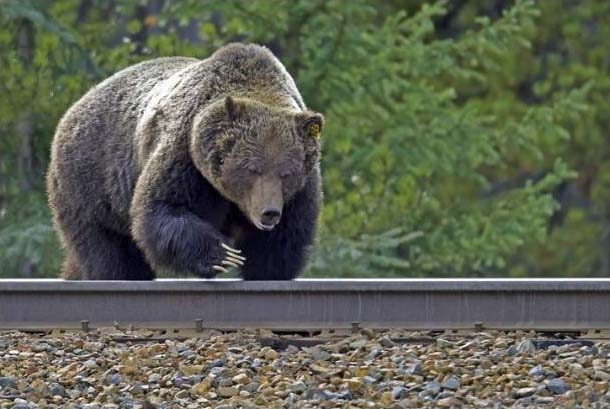
searching for grains and ungulates this spring - Date unknown Amar Athwal.
Banff Alberta - The Boss is back wandering the train tracks at great risk in search of grain and ungulate carcasses.
While movement of the Bow Valley's largest and most dominant bear, known as 122, varies throughout the season, the railway is a major travel route for him,
along with the nearby power line right-of-way.
He tends to hit the tracks hard when he first comes out of hibernation in spring in search of grain and dead deer and elk before moving on to natural foods,
all the while continuing to look for grain and carcasses.
The roughly 17-year-old bruin miraculously survived one train strike in 2010 near Vermilion Lakes, but 17 other grizzly bears since 2000 haven't been so
lucky.
In fact, train strikes are the leading cause of death of the threatened species in this area.
"We're just really hopeful we can keep mortality numbers as low as possible and deal with grain and other attractants," said Bill Hunt, resource
conservation manager for Banff National Park.
Just last week, two male black bears were killed on the train tracks, one by Baker Creek near Lake Louise, and the other near the water tower by the
Trans-Canada Highway east of Banff.
Hunt said the bear killed by the water tower was seen with another large adult male black bear, an animal that is commonly seen on or near that stretch of
railway.
"That bear's been doing that for years. Some bears have figured it out, while other ones killed haven't," he said.
The $1 million Parks Canada-Canadian Pacific Railway joint action study from 2012-2017 looked at ways to reduce bear mortality on the train tracks, and in
particular grizzly bear deaths.
It's been over a year since a team of researchers from the University Alberta, led by biologist Colleen Cassady St. Clair, headed up the CP-Parks Canada study,
tried to work out why so many grizzly bears are dying on the train tracks and ways to prevent it.
They looked at the line of the tracks and the surrounding topography, checked bear scat to find out what they were eating, and mounted cameras on some of CP's
locomotives to look at bears' reaction to oncoming trains, among other things.
One researcher invented a device that detects passing trains and relays that radio signal down track to trigger a warning device made up of lights and
electronic sounds to scare bears off the tracks when a train is approaching.
Cassady St. Clair said many factors were responsible for attracting bears to the railway, including high protein food such as elk and deer
carcasses.
The bruins also hone in on vegetation such as dandelions and light-loving species like berry-producing plants.
But she said it is apparent that grain is attracting bears too, noting about 110 tonnes of grain are being deposited in the park, enough to feed about 50 bears
for an entire year.
"Is that a lot of grain? Well, it really depends on your perspective," she said at a recent Bow Valley Naturalists' meeting in Banff.
"If you were a train operator, that's about 1.5 hopper cars among the hundreds of thousands that travel this route every year, so that's actually not so
bad," she added.
"If you're a bear, that's enough to feed you and 49 of your closest friends for a whole year in terms of calories."
Cassady St. Clair said grain remains a substantial attractant on the tracks even after efforts to reduce spillage such as grain car retrofits and changes to
stoppage rules in the park.
"I think those efforts have been effective and there will be a point of diminishing return, but there's no denying that grain remains a potent
attractant," she said.
Researchers also examined bear scat as a non-invasive way to see what bears were eating.
"One of the interesting things we found was that when scats contained grain, they were also more likely to contain disturbance-loving vegetation and ants
and ungulate hair," said Cassady St. Clair.
"That was especially interesting, because to that point we hadn't really associated the rail too much with opportunities to eat ungulates. But that might
actually be quite an important part of the strategy for some bears."
Of 31 individual grizzly bears fitted with GPS collars throughout the five-year project, Cassady St. Clair said there was tremendous variation in their
tendency to use the rails.
She said four bears travelled the train tracks more than others, the Boss, female grizzly bear 142, male bear 149, and male bear 128, which ended up being
killed on Highway 93.
"Those four bears stood out as using the rail a lot, more than 10 percent of the days over which they were monitored," she said, noting bear 122 is
the biggest bear in the Bow Valley while the other three are skinnier teenage bears.
"So the reasons they might have been on the rail might actually be quite different among those animals," she said, adding 122 sometimes actually
defends the railway as a resource. Generally, bigger bears eat more protein and that's the strategy that we think 122 is using when he targets the rail. So
he's maybe not so much after the grain as the other ones."
After the study, it was determined Parks Canada would tackle projects away from the railway while Canadian Pacific was tasked with dealing with many issues on
the railway.
Parks Canada is working on prescribed fire and forest thinning to restore grizzly bear habitat away from the railway, as well as creation of wildlife trails
adjacent to the railway.
The two areas to create wildlife trails away from the railway were identified because they are strike hot spots, including Five Mile Bridge west of Banff and
Morant's Curve east of Lake Louise.
At least seven grizzly bears have been killed by trains at Five Mile, which has been referred to as a killing field as trains speed up on a straightaway that
comes out of curves on the line.
Trains killed another three grizzlies at Morant's Curve.
"The goal is to give bears and other wildlife an alternate travel route in areas other than the railway," said Anne Forshner, a Parks Canada wildlife
ecologist for Lake Louise, Yoho, and Kootenay.
The work at Five Mile has been completed, with the creation of more than 20 kilometres of travel routes.
At Morant's Curve, three kilometres of trail have been cleared, with plans to clear another five kilometres this year.
"The long-term goal is to maintain those alternate travel routes," said Forshner.
Parks Canada does not expect to see results straightaway, but they're hopeful bears will use these alternate travel routes.
With cameras set up, wildlife use will be monitored over the next five to 10 years.
"We'll also use mortality data on the railway from bears, but also other wildlife, to look at before and after effects," said Forshner.
The other measure Parks Canada plans to use more of, is prescribed fires to restore grizzly bear habitat quality in the region, something the agency has been
doing since the 1980s.
An 800 hectare prescribed fire is on the books for the Baker Creek area this fall if conditions are right.
It's located 10 kilometres east of Lake Louise on the north side of the Trans-Canada Highway.
Forshner said research highlights grizzly bear foods are much more abundant in burned and thinned forests than other areas, leading bears to prefer to use
these areas compared to others.
"That tells us likely if we restore habitat away from the railway there's a good chance we can reduce the number of bears in those high risk areas,"
she said.
"This provides the basis as to why we want to use prescribed fire and thinning to restore habitat away from the railway."
Canadian Pacific Railway declined interview requests, instead sending an email statement.
Mallory McCredie, CP's media relations advisor, said the issue of bear mortality along the railway is a complex one.
"That is why CP funded a five-year, $1 million research project with Parks Canada and Alberta's academic institutions, the result, there is no easy
solution to prevent bear-train interactions," she wrote.
McCredie indicated CP has completed the first year of escape path widening, which CP had committed to last fall.
"The research showed that, in areas along our track with heavy brush, wildlife doesn't understand how to avoid a strike," she said.
"Our escape path widening is removing brush and trees along the corridor to reduce the tunneling effect and allow wildlife to move perpendicular to avoid
a strike."
McCredie wrote CP has committed $250,000 in each of 2018 and 2019 for wildlife mitigations, noting there will be discussions with Parks Canada on how to best
target those funds.
"CP is taking the steps it reasonably can to prevent wildlife mortality on the tracks, said McCredie in the statement.
"Our entire company, including our employees who live in the parks region, recognizes the importance of doing what we can to reduce contact with
bears."
Cathy Ellis.
provisions in Section 29 of the Canadian
Copyright Modernization Act.


